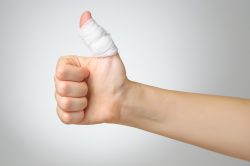
Researchers at the Perelman School of Medicine at the University of Pennsylvania along with the Plikus Laboratory for Development and Regenerative Biology at the University of California, Irvine, have discovered a way to heal wounds without scars by manipulating woulds to heal as regenerated skin. Previously thought to be impossible, the researchers have found a way to transform cells found in wounds into fat cells.
Adipocytes which are fat cells are typically found in the skin but they become lost when wounds heal as scars. Myofibroblasts are the most common cells found in wound healing which were thought to only form a scar. Scar tissue will not have hair follicles or fat cells which is what gives them their abnormal appearance. Using these characteristics, the researchers had the basis for their work which was comprised of changing the present myofibroblasts into fat cells which do not cause the typical scarring as the result of wound healing. The method was to regenerate hair follicles first then the fat would regenerate in response to those signals.
The study showed that fat and hair develop separately but not independently. Hair follicles will form first and the study discovered factors that were necessary for their formation. These additional factors were actually produced by the regenerating hair follicle converting surrounding myofibroblasts to regenerate as fat in place of a scar. This fat will not regenerate without the new hairs and once it does the new cells are indistinguishable from the existing fat cells giving the wound a more natural appearance.
The researchers identified a factor called Bone Morphogenetic Protein that sends the signal from the hair to the fat cells, instructing the myofibroblasts to turn into fat. This discovery alone was groundbreaking as it changed what was previously known about myofibroblasts. They were thought to be incapable of turning into a different type of cell. The study showed that they have the ability to influence cells and can be efficiently and stably converted into adipocytes. This transformation was shown in both mouse and human keloid cells which were grown in culture.
The discoveries show a great opportunity for wound healing to regenerate tissue rather than scarring. From a clinical standpoint the results are highly desirable and have the potential to revolutionize dermatology. Right now it is an unmet need.
The study also showed that the increase of fat cells in tissue might also be helpful for more than wound healing. Adipocyte loss is a fairly common complication of other conditions such as treatments for HIV and for the aging process when cells are lost naturally which leads to permanent deep wrinkles and discolouration.
To view the original scientific study click here: Regeneration of fat cells from myofibroblasts during wound healing





